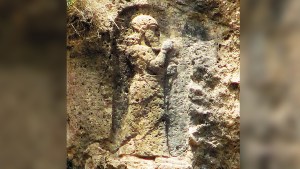Within the 11th-century walls of the Hereford Cathedral hangs a curious cacophony of images inscribed upon a large 5-feet tall by 4-feet-wide medieval map known as the Mappa Mundi. Dating back to 1285, the Mappa Mundi (“Map of the World”) is emblazoned with more than 500 illustrations of biblical events, exotic plants and animals, wild and strange creatures, and classical myths.
It remains the largest medieval map to survive the last 800 years, although it has become worn from hundreds of years of display, improper storage during the World War II era, and general decay caused by time. Today it is meticulously cared for and kept behind glass. It can be viewed during a visit to Hereford Cathedral or enjoyed digitally at this interactive website.
As was the popular trend in the Middle Ages, the map shows a circular world with East placed at the top, marking the rising of the sun and the second coming of Christ. Indeed, illustrated atop the map is an image of Christ with his hands held up to show the stigmata. On Christ’s right are images of faithful Christians being ushered to heaven, while the left shows the unfaithful being taken to hell, depicted by the open maw of a giant beast.
Jerusalem is placed directly in the center, another popular medieval trope that honors the Holy City as the center of the faithful world. There are many other ancient cities pictured, which still thrive today: Rome, Paris, and even Hereford.
There are many Bible passages illustrated over the canvas as well. Eden can be found at the top of the Mappa Mundi, a circular island surrounded by fire and water. Eve can be seen accepting a piece of fruit from a demon-faced serpent. The Red Sea has a clear path of what appears to be dry land crossing through the center, which represents the path taken during the Jewish Exodus, and the largest image on the map is the Tower of Babel, where man’s desire to build to heaven led to division through many languages.
Interestingly, Noah’s ark is depicted northeast of Jerusalem, in an area that would be on the modern-day Iran-Armenia border. This ties with the belief that the remains of the legendary vessel are located on Mount Ararat, where archaeologists still search for them today.

Read more:
Did Noah’s Ark really land in the biblical Mountains of Ararat?
Perhaps what is most striking about the Mappa Mundi is that amidst all these known cities and biblical passages that faith accepts can also be found depictions of ancient history, Greek myths, unbelievable races, and various flora and fauna that can only feel at home within a vivid imagination.
The columns of Hercules mark the entrance of the Strait of Gibralter, where the Greek demigod joined the Mediterranean Sea and the Atlantic Ocean. The Cretan labyrinth is depicted on a large island in the Mediterranean Sea and the Camp of Alexander the Great is set up in the Middle East. There are a number of mentions of Alexander written around the Mappa Mundi.
There are also several accounts of strange races drawn around the map. Blemmyes were a war-like, headless race with facial features placed upon their bodies. Sciapods were one men who walked on one leg, with an enormous foot which they could use to shade themselves from the sun. Troglodites were African cave dwellers who would remain naked and catch wild animals by jumping onto their backs.
It is perhaps significant that historical references, known cities, and Bible passages delineating salvation history would share the canvas with myths and legends that do not fit in the Christian faith. The Mappa Mundi gives an interesting glimpse into the medieval imagination and its willingness to explore the unknown.
